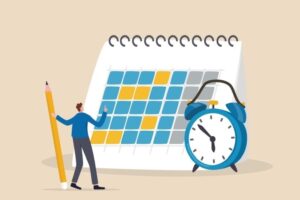
Customer Education: Business Priority Or Afterthought?
It’s Time To Make Customer Education A Business Priority
Customer education can easily get lost in the day-to-day juggle of priorities and pressures, yet most L&D teams are sitting on untapped goldmines of Instructional Design expertise that could transform customer relationships. But if your customers are engaged in high-quality training programs, it might be the answer to a lot of your learning and business problems.
Step Back And Look At The Bigger Picture
Customer education often starts with onboarding, but its potential stretches across the entire customer journey. From awareness and trial to adoption and expansion, every stage presents an opportunity to guide, support, and inspire. When you design learning experiences with this journey in mind, you create a content ecosystem that serves both your business goals and your customers’ success.
Think about your most successful employee onboarding program. Now imagine applying those same learning principles (personalization, scenario-based learning, peer collaboration) to your customers. Your role in that is to determine when you need content that:
- Is available on demand and resolves immediate challenges for the customer (think microlearning modules that solve specific workflow problems).
- Draws customers away from their day-to-day routine and engages them in a new challenge that adds to the learner experience (like certification programs that turn users into product experts).
This approach naturally expands your scope beyond onboarding. You begin to consider mandatory training for different end users, product training for power users, performance enablement for champions, and even eCommerce opportunities when your offering is really sophisticated.
Start On Day 1
Thoughtful onboarding builds confidence, reduces friction, and lays the foundation for long-term engagement. It’s not just a welcome—it’s a launchpad. And for many customers, onboarding is the moment they decide whether your product is worth the effort. Yet too often, onboarding is treated as a checklist—an email series, a few help articles, maybe a webinar.
You already know how to create compelling learning journeys, design assessments that stick, and measure behavior change. Instead of generic tutorials, create role-based learning paths with interactive simulations. The potential result? Significant reductions in time-to-first-value and decreased early churn.
Customer Education Is A Quiet But Powerful Driver Of Revenue
One of the most overlooked growth levers is education. When customers understand how to get more value from your product, they naturally explore more features, expand their usage, and deepen their investment. This kind of growth doesn’t require a sales pitch, it happens when customers feel confident and capable.
While sales teams focus on closing deals and product teams build features, L&D professionals understand how to create “sticky” learning experiences that change behavior. When you apply this to customers, you’re not just reducing churn; you’re actively driving expansion revenue.
Turn Product Adoption Into Community Building
Some of the strongest customer relationships are built outside of support tickets and product demos. They’re built in forums, user groups, and shared learning spaces. Training can be the spark that brings people together, and an external learning community can create a sense of belonging that turns users into advocates.
Customer user groups don’t just share tips—they complete certification tracks together, creating bonds that extend far beyond the platform. These community-educated customers consistently show higher satisfaction scores and generate more referrals.
It Takes A Village
Customer education works best when it’s a team effort. Marketing understands what customers care about. Product knows what they need to succeed. Support sees where they struggle. And L&D knows how to teach.
But customer education efforts can fail when L&D are brought in at the end, rather than included from the get-go. If the foundations are built by teams that don’t understand learning science, you can end up with an ad-hoc content program instead of a learning experience. This is where L&D professionals shine, by bringing expertise in learning objectives and outcome measurement that transforms scattered resources into strategic education programs.
Audit your company’s existing customer onboarding materials through an L&D lens. You’ll likely find content that tells rather than teaches, lacks clear learning objectives, and measures completion rather than competency. That’s your roadmap for impact.
From Reactive To Proactive
Too often, training is created in response to problems. A spike in support tickets, a drop in usage, a missed renewal. But what if education came first? What if you could guide customers before they hit a roadblock? Proactive education doesn’t just solve problems, it prevents them. And that shift can transform your entire customer experience.
Identify your top customer stumbling blocks and create just-in-time learning modules that surface before users hit those obstacles. What will make this a success? L&D-style needs analysis and performance support design. You’re trained to identify performance gaps and design interventions. Apply these skills to customer journey mapping, and you’ll spot opportunities that other teams miss entirely.
Tie Learning With Business Outcomes
Customer education needs to drive impact. When learning experiences are designed with outcomes in mind, customers apply what they’ve learned, solve problems faster, and get more value from your product.
And that leads to:
- Better adoption and performance. Customers who are supported with learning use your product more effectively, which means fewer tickets and more “Aha” moments. Research shows that trained customers demonstrate significantly higher product adoption scores.
- Stronger relationships. Learning connects customers with your support and product teams, and even with each other. Engaged customers ask better questions, share honest feedback, and become product champions. Studies indicate that certified users often generate more revenue per seat and have lower churn rates.
- More growth. Happy, confident customers stay longer. They explore new features, upgrade, and expand their use of your product. And they refer others, helping you grow without increasing your marketing spend.
Make Customer Education A Business Priority
If you’re in HR or L&D, your skills aren’t just aligned with customer education needs—they’re essential for success. Companies are desperately trying to figure out customer education, often failing because they lack fundamental learning design expertise.
Position yourself as the strategic partner who can transform customer relationships through learning. Start small, and the results will speak for themselves. Offer to redesign one customer onboarding sequence using Instructional Design principles.
When you’re making your business case, present customer education as what it really is: performance enablement for external stakeholders. Frame it in language business leaders understand: reduced churn, increased expansion revenue, and higher customer lifetime value.
The question you should be asking yourself isn’t whether customer education matters. It’s whether you’re ready to lead the charge.
Source link




